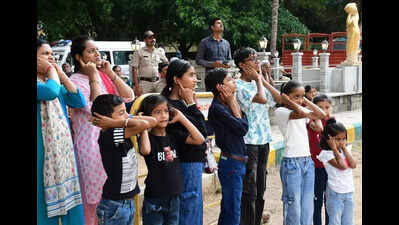Bengaluru: Sirens pierced the afternoon air as more than 600 personnel descended in Ulsoor for ‘Operation Abhyasa', a large-scale civil defence mock drill in Bengaluru, part of a larger exercise conducted across the country.
The comprehensive exercise, held at the fire and emergency department headquarters, simulated various emergency scenarios including air raids, bomb blasts, and civilian evacuations—all designed to test and demonstrate the rapid response capabilities of emergency services.
At 3.58pm, three sharp siren blasts signalled the commencement of operations. Volunteers immediately scattered across the ground as police worked efficiently to control the simulated crowd. Ambulances, with sirens blaring, rushed to the scene ready to provide medical assistance.
The first scenario showcased a boat rescue operation on Ulsoor lake, which is opposite the fire and emergency department headquarters. Rescue teams sprang into action, with personnel diving into the water whilst two boats—each manned by seven rowers—headed towards the islands to simulate civilian rescues.
The operation demonstrated remarkable efficiency, with stretchers prepared at the lake's edge and "rescued" civilians swiftly carried to waiting ambulances. The entire water rescue was completed within a 10-minute timeframe.
Attention then shifted to the Karnataka State Disaster Response Force building for the second stage of the exercise. As three siren blasts echoed through the air, the building was evacuated to simulate an air strike and fire outbreak. Tension mounted as firecrackers mimicked bomb blasts, sending thick smoke billowing across the premises.
Two fire engines, alongside a ladder truck and four ambulances arrived. Firefighters uncoiled hoses, extended ladders skyward, and directed powerful jets of water through the smoke-filled air. Simultaneously, a separate team braved the smoke to rescue two civilians trapped inside the building. This "ladder rescue" operation highlighted the crucial coordination needed during aerial emergencies.
The team then signalled a ‘Code red' by six siren wails indicating a high-level emergency requiring immediate evacuation — approximately 40 volunteers rushed to safety while attention focused on a nearby tower where a ‘civilian' awaited rescue. It ended with a long single siren.
And, then the final act featured a dramatic tower rescue. Two harnessed rescuers ascended the structure and secured the individual to a stretcher. On the ground, six team members held a safety net as the stretcher was carefully lowered by rope, demonstrating the precise teamwork required in such scenarios.
A single, short siren finally marked the conclusion of the exercise. Then, after a planned break, a five-minute blackout — done during war to make potential targets invisible — was simulated at 7.05pm.
As per the initial plan, 475 civil defence wardens, 70 firemen, 18 SDRF members, 45 NDRF members, five from railways civil defence team, 40 home guards, 130 NCC cadets, 20 scouts and guides, 17 Red Cross volunteers, four from Karnataka police wireless team, five from CRPF, five from the intelligence bureau and 36 members from Ramaiah Hospital were to participate.
-With inputs from Prilesha Pasupati









